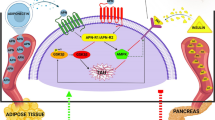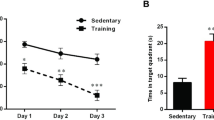Abstract
In the present study, we investigated the effects of treadmill exercise in early and chronic diabetic stages on parvalbumin (PV) immunoreactivity in the subgranular zone of the dentate gyrus of Zucker diabetic fatty (ZDF) and its lean control rats (ZLC). To investigate the effects, ZLC and ZDF rats at 6 or 23 weeks of age were put on a treadmill with or without running for 1 h/day/5 consecutive days at 16–22 m/min for 5 weeks or 12–16 m/min for 7 weeks, respectively. Physical exercise in pre-diabetic rats prevented onset of diabetes, while exercise in rats at chronic diabetic stage significantly reduced blood glucose levels. In addition, physical exercise in the pre-diabetic rats significantly increased PV immunoreactive fibers in the strata oriens and radiatum of the CA1-3 region and in the polymorphic and molecular layers of the dentate gyrus compared to that in sedentary controls. However, in rats at chronic stages, PV immunoreactivity was slightly increased in the CA1-3 region as well as in the dentate gyrus compared to that in the sedentary controls. These results suggest that physical exercise has differential effects on blood glucose levels and PV immunoreactivity according to diabetic stages. Early exercise improves diabetic phenotype and PV immunoreactive fibers in the rat hippocampus.





Similar content being viewed by others
References
Seemayer TA, Oligny LL, Tannenbaum GS, Goldman H, Colle E (1980) Animal model of human disease. Diabetes mellitus. Am J Pathol 101:485–488
Vora JP, Zimsen SM, Houghton DC, Anderson S (1996) Evolution of metabolic and renal changes in the ZDF/Drt-fa rat model of type II diabetes. J Am Soc Nephrol 7:113–117
Etgen GJ, Oldham BA (2000) Profiling of Zucker diabetic fatty rats in their progression to the overt diabetic state. Metabolism 49:684–688
Gispen WH, Biessels G-H (2000) Cognition and synaptic plasticity in diabetes mellitus. Trends Neurosci 23:542–549
Magarinõs AM, McEwen BS (2000) Experimental diabetes in rats causes hippocampal dendritic and synaptic reorganization and increased glucocorticoid reactivity to stress. Proc Natl Acad Sci USA 97:11056–11061
Lang BT, Yan Y, Dempsey RJ, Vemuganti R (2009) Impaired neurogenesis in adult type-2 diabetic rats. Brain Res 1258:25–33
Eichenbaum H, Otto T (1992) The hippocampus—what does it do? Behav Neural Biol 57:2–36
Phillips RG, LeDoux JE (1992) Differential contribution of amygdala and hippocampus to cued and contextual fear conditioning. Behav Neurosci 106:274–285
Biessels GJ, Deary IJ, Ryan CM (2008) Cognition and diabetes: a lifespan perspective. Lancet Neurol 7:184–190
Bruehl H, Wolf OT, Sweat V, Tirsi A, Richardson S, Convit A (2009) Modifiers of cognitive function and brain structure in middle-aged and elderly individuals with type 2 diabetes mellitus. Brain Res 1280:186–194
Sloviter RS, Ali-Akbarian L, Horvath KD, Menkens KA (2001) Substance P receptor expression by inhibitory interneurons of the rat hippocampus: enhanced detection using improved immunocytochemical methods for the preservation and colocalization of GABA and other neuronal markers. J Comp Neurol 430:283–305
Miles R, Wong RK (1983) Single neurones can initiate synchronized population discharge in the hippocampus. Nature 306:371–373
Overstreet LS, Hentges ST, Bumaschny VF et al (2004) A transgenic marker for newly born granule cells in dentate gyrus. J Neurosci 24:3251–3259
Hevener AL, Reichart D, Olefsky J (2000) Exercise and thiazolidinedione therapy normalize insulin action in the obese Zucker fatty rat. Diabetes 49:2154–2159
Pold R, Jensen LS, Jessen N et al (2005) Long-term AICAR administration and exercise prevents diabetes in ZDF rats. Diabetes 54:928–934
Flores MB, Fernandes MF, Ropelle ER et al (2006) Exercise improves insulin and leptin sensitivity in hypothalamus of Wistar rats. Diabetes 55:2554–2561
Reisi P, Alaei H, Babri S, Sharifi MR, Mohaddes G, Soleimannejad E (2009) Determination of the extracellular basal levels of glutamate and GABA at dentate gyrus of streptozotocin-induced diabetic rats. Pathophysiology 16:63–66
Campbell JE, Király MA, Atkinson DJ, D’souza AM, Vranic M, Riddell MC (2010) Regular exercise prevents the development of hyperglucocorticoidemia via adaptations in the brain and adrenal glands in male Zucker diabetic fatty rats. Am J Physiol Regul Integr Comp Physiol 299:R168–R176
Yi SS, Hwang IK, Yoo KY et al (2009) Effects of treadmill exercise on cell proliferation and differentiation in the subgranular zone of the dentate gyrus in a rat model of type II diabetes. Neurochem Res 34:1039–1046
Hwang IK, Yi SS, Song W, Won MH, Yoon YS, Seong JK (2010) Effects of age and treadmill exercise in chronic diabetic stages on neuroblast differentiation in a rat model of type 2 diabetes. Brain Res 1341:63–71
Eilam R, Davidson A, Gozes I, Segal M (1999) Locomotor activity causes a rapid up-regulation of vasoactive intestinal peptide in the rat hippocampus. Hippocampus 9:534–541
Hwang IK, Yi SS, Kim YN et al (2008) Reduced hippocampal cell differentiation in the subgranular zone of the dentate gyrus in a rat model of type II diabetes. Neurochem Res 33:394–400
Song W, Kwak HB, Lawler JM (2006) Exercise training attenuates age-induced changes in apoptotic signaling in rat skeletal muscle. Antioxid Redox Signal 8:517–528
Paxinos G (2007) Watson C. The rat brain in stereotaxic coordinates. Elsevier Academic Press, Amsterdam
Jiang Q, Heneka M, Landreth GE (2008) The role of peroxisome proliferator-activated receptor-γ (PPARγ) in Alzheimer’s disease: therapeutic implications. CNS Drugs 22:1–14
Nelson TJ, Sun MK, Hongpaisan J, Alkon DL (2008) Insulin, PKC signaling pathways and synaptic remodeling during memory storage and neuronal repair. Eur J Pharmacol 585:76–87
Peterson RG, Shaw WN, Neel MA, Little KA, Eichberg J (1990) Zucker diabetic fatty rat as a model for non-insulin-dependent diabetes mellitus. ILAR J 32:16–19
Tokuyama Y, Sturis J, DePaoli AM et al (1995) Evolution of beta-cell dysfunction in the male Zucker diabetic fatty rat. Diabetes 44:1447–1457
Etgen GJ Jr, Jensen J, Wilson CM, Hunt DG, Cushman SW, Ivy JL (1997) Exercise training reverses insulin resistance in muscle by enhanced recruitment of GLUT-4 to the cell surface. Am J Physiol 272:E864–E869
Morrison PD, Mackinnon MW, Bartrup JT, Skett PG, Stone TW (1992) Changes in adenosine sensitivity in the hippocampus of rats with streptozotocin-induced diabetes. Br J Pharmacol 105:1004–1008
Lolova I, Davidoff M (1992) Age-related morphological and morphometrical changes in parvalbumin- and calbindin-immunoreactive neurons in the rat hippocampal formation. Mech Ageing Dev 66:195–211
Gomes da Silva S, Doná F, da Silva Fernandes MJ, Scorza FA, Cavalheiro EA, Arida RM (2010) Physical exercise during the adolescent period of life increases hippocampal parvalbumin expression. Brain Dev 32:137–142
Arida RM, Scorza CA, da Silva AV, Scorza FA, Cavalheiro EA (2004) Differential effects of spontaneous versus forced exercise in rats on the staining of parvalbumin-positive neurons in the hippocampal formation. Neurosci Lett 364:135–138
Arida RM, Scorza CA, Scorza FA, Gomes da Silva S, da Graça Naffah-Mazzacoratti M, Cavalheiro EA (2007) Effects of different types of physical exercise on the staining of parvalbumin-positive neurons in the hippocampal formation of rats with epilepsy. Prog Neuropsychopharmacol Biol Psychiatry 31:814–822
Molteni R, Ying Z, Gómez-Pinilla F (2002) Differential effects of acute and chronic exercise on plasticity-related genes in the rat hippocampus revealed by microarray. Eur J Neurosci 16:1107–1116
Bhattacharyya BJ, Banisadr G, Jung H et al (2008) The chemokine stromal cell-derived factor-1 regulates GABAergic inputs to neural progenitors in the postnatal dentate gyrus. J Neurosci 28:6720–6730
Jones KR, Fariñas I, Backus C, Reichardt LF (1994) Targeted disruption of the BDNF gene perturbs brain and sensory neuron development but not motor neuron development. Cell 76:989–999
Acknowledgments
This work was supported by the National Research Foundation of Korea Grant funded by the Korean Government (MEST), Republic of Korea (2010-0007712).
Author information
Authors and Affiliations
Corresponding authors
Additional information
In Koo Hwang and Sun Shin Yi contributed equally to this article.
Rights and permissions
About this article
Cite this article
Hwang, I.K., Yi, S.S., Yoo, KY. et al. Differential Effects of Treadmill Exercise in Early and Chronic Diabetic Stages on Parvalbumin Immunoreactivity in the Hippocampus of a Rat Model of Type 2 Diabetes. Neurochem Res 36, 1526–1532 (2011). https://doi.org/10.1007/s11064-011-0480-8
Accepted:
Published:
Issue Date:
DOI: https://doi.org/10.1007/s11064-011-0480-8




